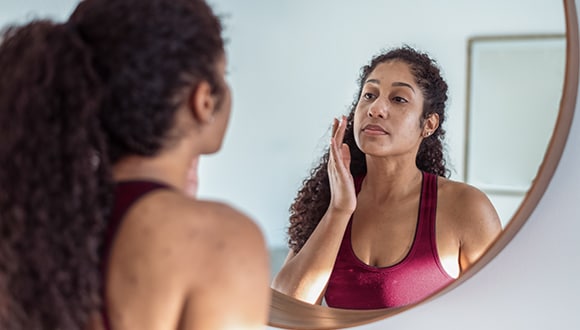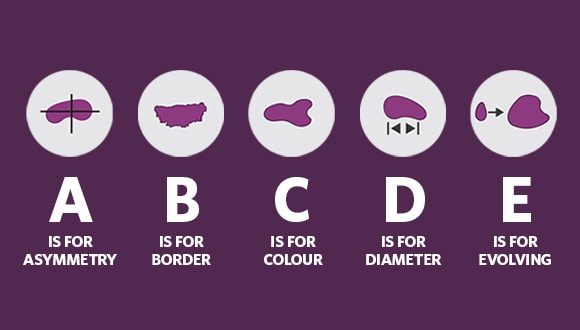Skin cancer checks: how to spot the signs
If caught early, skin cancer can often be successfully treated so checking your skin regularly – and knowing what to look for – is vital.
Though suntans fade, the damage they cause lasts a lifetime, increasing your risk of skin cancer. Regular skin cancer checks are the key to early detection.
By the age of 70, two in three of us will be diagnosed with skin cancer. And it’s true that Australia has one of the highest rates of skin cancer in the world.
To minimise damage, use sun protection when UV levels reach three or above. You can check UV levels via the SunSmart app, which will give you daily UV and sun protection alerts. Slip on protective clothing, slop on SPF30 (or higher) broad-spectrum, water-resistant sunscreen, slap on a broad-brimmed hat, seek shade, and slide on sunglasses.
It’s also important to be savvy about skin cancer signs. “When it comes to successfully treating skin cancer, early detection is key,” says Professor Anne Cust, chair of the Cancer Council’s Skin Cancer Committee. That’s why you need to be informed about skin cancer and its signs.
How do I check for signs of skin cancer?
It's estimated that more than 17,000 Aussies were diagnosed with melanoma this year, and 1,281 Aussies lost their lives to skin cancer.
However, melanoma is one of the most preventable cancers, according to the Cancer Council. Exposure to UV radiation causes 95% of melanomas.
“If detected early, most skin cancers are successfully treated. We encourage you to develop a regular habit of checking your skin, including skin not normally exposed to the sun, for new spots and changes to existing freckles or moles,” says Prof Cust.
When checking your skin, enlist the help of someone close to you to examine hard-to-see areas such as underarms, buttocks, soles of your feet and the back of your legs and shoulders.
Making the check on your own? Then use both a full-length and hand-held mirror to examine hard-to-reach areas. Make a date with a friend or relative to do a mutual skin cancer check where you both wear shorts and singlets or swimming costumes and check areas like backs of your legs and shoulders.
“Make sure you also check ears, under the nails, between your fingers and all over your scalp where it is hidden by hair,” Prof Cust advises. Use a hairdryer to shift areas of hair so you can see your scalp more clearly.
“We recommend that if anyone notices anything new, unusual or changing, they go to the GP to get it checked out,” Prof Cust says. “Skin cancers can often be diagnosed and managed by a GP. If someone has a skin cancer that requires further treatment, a GP may refer them to a specialist such as a dermatologist.”
For anyone with a personal or family history of skin cancer, they should speak to a GP about developing what Cancer Australia calls a ‘surveillance plan’ – a plan to closely watch for any signs, which can include examining the skin or imaging.
“Tattoos may make it more difficult to identify changes on your skin, so people with tattoos may benefit from seeing a doctor who can use dermoscopy [refers to the examination of the skin using skin surface microscopy] and other detection tools to monitor the skin,” Prof Cust says. “People with tattoos may also choose to speak to their doctor about developing a surveillance plan, depending on their individual circumstances.”

Skin cancer checklist: where to look
To ensure your skin check is thorough, the Cancer Council suggests you undress completely and stand in a good light. As you examine your skin, keep a record of the date and anything of note.
Check:
- your torso (front, back and sides) and under armpits
- arms, hands, palms and fingers
- buttocks, legs and feet (including the soles)
- head, shoulders, scalp, neck and ears
- face, including nose, lips and under the chin
- the skin between areas like fingers and toes, and under toenails.
When to seek help
Health Direct says you should alert your doctor if you notice:
- itching, flaking, bleeding, crusting, weeping, or ulceration of any spots or moles since you last checked
- new spots that are dry and scaly; pearly, pale red, black or dark brown; lumpy, or have uneven or smudgy outlines
- freckles, birthmarks or moles that have changed shape, size or colour (including darkening, lightening or simply a variation or irregularity in pigmentation)
- appearance of new moles
- a sore that doesn’t heal.
If skin cancer is detected, your GP may suggest a treatment like special topical cream applied to skin or cryotherapy (freezing). They may also refer you to a specialist for a small surgical procedure. A tissue sample will then be taken and sent for examination to determine if the spot is a melanoma or non-melanoma, such as squamous cell carcinoma or a basal cell carcinoma.
Early detection is key
The most dangerous skin cancer, melanoma, may appear brown, blackish-red, pinkish or flesh toned and have asymmetric or smudgy borders. According to the Cancer Council early detection can mean melanoma is often curable if found early, before it has grown deeper into the dermis of the skin and spread.
The Cancer Council says squamous cell carcinoma often presents as a thickened, scaly spot which grows over some months and may later bleed or ulcerate. Basal cell carcinoma, the most common but least dangerous form of skin cancer, is usually a small lumpy or scaly area of skin that appears red, pale or pearly. As it grows it may become ulcerated.
“Remember that quick detection is critical to stopping a small skin cancer from spreading to other parts of your body,” says Prof Cust. “The cure rate for melanoma treated in its early stages is over 90% and the cure rate for other skin cancers detected early is close to 100%.”
Use the ABCDE of melanoma detection to check for:
- A – Asymmetry: if the spot or lesion is divided in half, the two halves are not a mirror image.
- B – Border: a spot with a spreading or irregular edge.
- C – Colour: a spot with a number of different colours through it.
- D – Diameter: usually over 6mm.
- E – Evolving: changing and growing.

What’s your skin cancer risk?
Every Aussie is at risk but the risk is worse if you have:
- a large number of moles, or moles with an irregular shape and uneven colour
- spent your childhood in Australia
- unprotected exposure to UV radiation, particularly a history of short, intense periods of sun exposure and sunburn on weekends and holidays
- actively tanned or used solariums
- worked outdoors or been exposed to arsenic
- a weakened immune system
- suffered sunburn in the past
- fair skin that burns easily, freckles or does not tan
- red or fair hair, blue or green eyes
- a family history of melanoma
- had skin cancer in the past
- have skin conditions like sunspots.
“Young people need to know that skin cancer doesn’t discriminate”
Emily Egan, 25, is a communications officer and the Cancer Council ACT’s SunSmart ambassador for young people.
“Growing up, my parents encouraged me to wear sunscreen every day. I’ve never laid out in the sun – unlike most of my friends I got my suntan from a bottle.
“I was 18 when I became aware of the importance of being sun safe. I was visiting my doctor and mentioned having a skin check as I’d recently seen an ad on TV by the Cancer Council.
“I’ve always had a mole under my chin. I hadn’t noticed anything unusual about it but when the GP ran a blue light over me, she determined that the mole was potentially at risk for skin cancer. It had started to change colour, which concerned her and she recommended I have the mole removed immediately.
“The removal of the mole was a quick process – around 20 minutes. I went to a specialised skin clinic; under a local anaesthetic they lasered the mole off and put in two stitches. Some parts of the removed mole were sent for analysis. When it came back it was the lowest grade. As it had begun to change colour, it was lucky I’d caught it in time as these things can get worse very quickly.
“Skin cancer doesn’t just affect people who sit in the sun all day. I visit my GP every six months for skin checks and I now visit schools to educate children about the importance of sun safety. I tell them to make these sun safe habits now, even in winter. Young people need to know that skin cancer doesn’t discriminate. It can happen to you at any age.”
For more information call the Cancer Council Helpline on 13 11 20.
Words by Charmaine Yabsley
Published November 2022
Related articles
How to check for skin cancer
Australia is the skin cancer capital of the world. Here’s how you can check for signs of skin cancer and lower your risk of being exposed.
Types of skin cancers
There are numerous kinds of non-cancerous skin tumours – here are some of the most common types.
Are you at risk?
Because of Australia’s climate we have the highest incidence of skin cancer in the world.
Choosing a specialist
Your GP will be able to recommend and refer you to a skin cancer specialist.